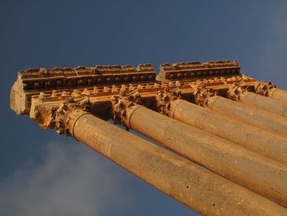- Visit Lebanon

- Beqaa Valley

- Baalbek
Baalbek

Located about 85 kilometers northeast of Beirut and 35 kilometers northeast of Zahle, Baalbek is a rugged but friendly modern place and home to the world-class and most impressive must-see of Lebanon: The UNESCO-recognized Roman archeological site. Dominated by Shi'ites, this relatively poor and traditional town is the administration center of the northern Beqaa Valley, yet better known as one of the Hezbollah strongholds in the country.
The history of Baalbek goes back to Phoenician times, starting around 3000 BC. In the first millennium BC, an enclosed court was built there dedicated to the god Baal, from where the city takes its original name. In 333 BC, the Greeks took over the city, enlarged the court and erected a podium. The city was renamed Heliopolis, meaning ‘city of the sun'. Heliopolis became a Roman colony under Julius Caesar in 47 BC, who named the city after his daughter Julia. During this period, the city - with its huge temples - became one of the prime places of worship of the Roman Empire. With the arrival of the Arabs in 634, the town returned to its original name and since then is known as Baalbek. During the Civil War (1975 - 1990), the village was the base for Palestinian and Syrian forces and in the beginning of the 1980s it became a Hezbollah stronghold, clearly apparent by the many posters displayed of its current leader Hassan Nasrallah. Most recently, Baalbek was subjected to Israeli raids and air attacks during the 2006 fighting.
In sum, one cannot leave Lebanon without having visited Baalbek. Note that summers can be extremely hot there, while in winter Baalbek can become chilly and even snowy.
